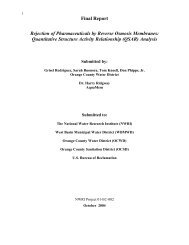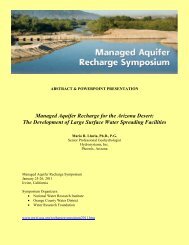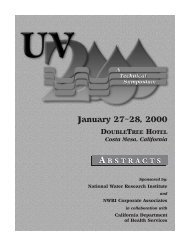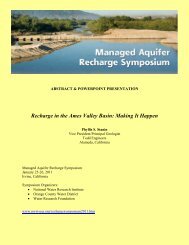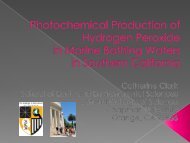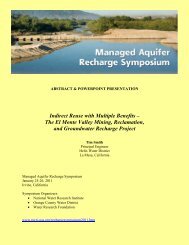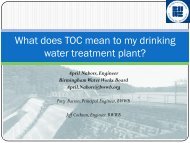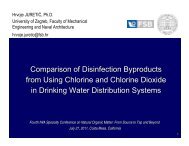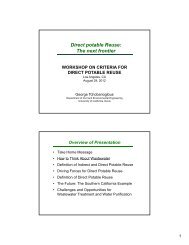Presentation - National Water Research Institute
Presentation - National Water Research Institute
Presentation - National Water Research Institute
You also want an ePaper? Increase the reach of your titles
YUMPU automatically turns print PDFs into web optimized ePapers that Google loves.
Characterisation of Organic Matter in Alum Treated<br />
Drinking <strong>Water</strong> using Reverse Phase‐High<br />
Performance Liquid Chromatography and<br />
Ion‐Exchange Resins<br />
Dongsheng Wang 1,2 , Linan Xing 1 , Mohamad Fared Murshed 2 , Theodore W.C. Lo 3 ,<br />
Rolando Fabris 4 , Christopher W.K. Chow 1,2,4 , John van Leeuwen 1,2 , Mary Drikas 1,2,4<br />
1 State Key Lab of Environmental Aquatic Chemistry, RCEES, CAS, Beijing, China.<br />
2 SA <strong>Water</strong> Centre for <strong>Water</strong> Management and Reuse, University of South Australia, Mawson Lakes,<br />
South Australia, Australia.<br />
3. Laboratory Lb Animal lS Service Centre, The Chinese University i of Hong Kong, Prince Pi of Wl Wales Hospital,<br />
Shatin, Hong Kong.<br />
4<br />
Australian <strong>Water</strong> Quality Centre, SA <strong>Water</strong>, Adelaide, South Australia, Australia.
Outlines<br />
o Resin fractionation‐hydrophobicity & hydrophilicity<br />
o Characterization of NOM using RP‐HPLC<br />
o Key component of our RP‐HPLC approach<br />
o Comparison of resin fractionation method and<br />
RPHPLC for NOM<br />
o Impact of coagulation on chromatographic behaviour
Resin fractionation<br />
~ Resin fractionation has been introduced to<br />
determine hydrophobicity of NOM in order to<br />
optimize coagulation performance<br />
~ Resin fractionation is based on adsorption onto<br />
different absorbent resins by calculated the organic<br />
concentration before and after contact with resins.<br />
• An early case study in Australia has demonstrated dthe link<br />
between source water hydrophobic fraction and<br />
coagulant dose<br />
• By characterising organics based on their hydrophobicity<br />
and hydrophilicity, the treatability of NOM can be<br />
determined
Earlier work on resin fractionation<br />
Chow, C.W.K., Fabris R. and Drikas, M. (2004) A Rapid<br />
Fractionation Technique To Characterise Natural Organic<br />
Matter For The Optimisation Of <strong>Water</strong> Treatment Processes. J<br />
<strong>Water</strong> SRT – Aqua 53(2) 85‐92.<br />
Chow, C.W.K., Fabris R., Drikas, M. and Holmes, M. (2005) A<br />
Case Study of Treatment Performance and Organic Character.<br />
J<strong>Water</strong>SRT– Aqua 54(6) 385‐395.<br />
However, resin fractionation was recognized as a time<br />
consuming technique and new alternative technique<br />
using HPLC has been introduced
Characterization of NOM using RP HPLC<br />
→ Since 80’s, researchers use RP HPLC to characterize HA and FA.<br />
→ In recent years, people are working for finding standard materials to compare<br />
with the polarity of NOM. Moreover, they combine with other advanced<br />
techniques, such as:<br />
i. pyrolysis‐gas chromatography‐mass spectrometry (Py‐GC‐MS)<br />
ii. solid state 13 C‐NMR spectroscopy<br />
iii. diffuse reflectance infrared Fourier transform (DRIFT).<br />
→ However, most of them considered to consume considerable time and effort,<br />
and require relatively expensive and complex instrumentation.<br />
→ Therefore, this RP HPLC has been introduced which is:<br />
o The detections all based on concentration NOM samples<br />
o Recovery tends out between 70% to 200‐300%<br />
o there are size exclusion effect during the detection
Mechanism of RPHPLC<br />
‣ The principle of operation is that organic material in an<br />
aqueous solution is introduced to a hydrophobic bonded HPLC<br />
column (eg. C18) which adsorbs the hydrophobic materials<br />
while the hydrophilic materials remain in the carrier and exit<br />
immediately to the detector.<br />
‣ After a set time period, the phase of the eluent is changed to a<br />
predominantly polar organic solvent (ie. reversing the phase) and<br />
the adsorbed hydrophobic material is desorbed from the column<br />
and flows to the detector.
Key component of our RP HPLC approach<br />
a. Optimized Reverse Phase HPLC Liquid System Program<br />
b. Deterioration and reproducibility<br />
c. Background Correction<br />
b)<br />
0.08<br />
3 Repeat tInjections<br />
UV absorbance @ 254nm (cm -1 )<br />
0.07<br />
0.06<br />
0.05<br />
0.04<br />
0.03<br />
0.02<br />
0.01<br />
pure water<br />
Morgan raw<br />
Middle River raw<br />
MR<br />
MG<br />
MilliQ<br />
0.00<br />
0 5 10 15 20<br />
Retention time (min)
Key component of our RP HPLC approach<br />
d. Quantifying chromatography results using peak fitting<br />
• Peak fitting software (Version 4, Systat Software Inc.) was used to resolve peak<br />
components based on statistically ideal fits using various peak shapes<br />
• Total peak area removal for the RPHPLC profile was calculated by using the<br />
difference between the peak area of the resolved peaks (after peak fitting) of<br />
raw and treated water from the RPHPLC scans<br />
Peak 1 to 4 with low retention time were defined as the<br />
RPHPLC‐hydrophilic proportion<br />
Peak 5 to 7, detected at longer retention time, were<br />
defined as the RPHPLC‐hydrophobic proportion
Natural water sample selection‐High SUVA water<br />
Morgan – River Murray (<strong>Water</strong><br />
Source for South Australia)<br />
Middle River Reservoir –<br />
Kangaroo Island off the coast<br />
of South Australia<br />
Colour: 58 HU<br />
DOC: 8.8 88mg/L<br />
UV 254 : 0.325 cm ‐1<br />
SUVA: 3.7 m ‐1 mg ‐1 L<br />
Colour: 145 HU<br />
DOC: 12.4 mg/L<br />
UV ‐1<br />
254 : 0.660 cm<br />
SUVA: 5.0 m ‐1 mg ‐1 L
Comparison of resin fractionation method and<br />
RPHPLC for NOM<br />
RPHPLC profile of isolated resin sample…..<br />
Resin fractionation<br />
Percentage of peak area result using Peak fitting software<br />
the resin‐hydrophobic fraction<br />
not only contains RPHPLChydrophobic<br />
components but<br />
also RPHPLC‐hydrophilic<br />
components
Impact of coagulation on chromatographic behaviour<br />
A treatment simulation test, the ‘Jar test’ was conducted<br />
on Morgan and Middle river raw water<br />
Jar testing was performed at pH 5.5, 6, 7 and 8.5 at dose<br />
from low to high (60 – 200 mg/L)<br />
According to the profiles, it<br />
can be seen that with the<br />
increase in alum dose, both<br />
the hydrophobic and<br />
hydrophilic proportions<br />
decreased gradually
Impact of coagulation on chromatographic behaviour<br />
Peak 1 easily can be removed by<br />
coagulation<br />
Hydrophilic peak (2‐4) can be<br />
removed better than<br />
hydrophobic peak (5‐7)
Comparison of organic character of the recalcitrant organic at<br />
maximum DOC removal coagulation<br />
maximum DOC removal coagulation<br />
Molecular weight<br />
distribution<br />
‐ Max alum coagulation dose at 200 mg/L<br />
‐ the removal efficiency of the hydrophilic proportion (Peak 2‐4) is lower than that of<br />
the hydrophobic proportion (Peak 5‐7)<br />
‐ RPHPLC‐hydrophilic contains components of the resin‐hydrophobic fraction which is<br />
expected to be removed by coagulation.
Comparison with resin fractionation –Treated waters<br />
UV abs sorbance @ 254 nm<br />
(cm -1 )<br />
0.018<br />
0.015<br />
Middle River treated<br />
Hydrophpbic of Middle River treated<br />
Hydrophilic of Middle River treated<br />
The peak areas 0.012 of each peak for the treated Middle River water were higher than that of<br />
0.009<br />
treated Morgan 0.009 water.<br />
0.015<br />
0.012<br />
Morgan treated<br />
Hydrophobic of Morgan treated<br />
Hydrophilic of Morgan treated<br />
0.006<br />
However, the peak area percentages of resin hydrophobic and resin hydrophilic for the two<br />
0.003<br />
0.003<br />
treated t waters were similar<br />
il<br />
0.000<br />
10 100 1000 10000 100000<br />
Apparent molecular weight (Da)<br />
0.006<br />
0.000<br />
10 100 1000 10000 100000<br />
Apparent molecular weight (Da)
Comparison with resin fractionation –Treated waters<br />
Precentage Pea ak Area (%)<br />
100<br />
90<br />
80<br />
70<br />
60<br />
50<br />
40<br />
30<br />
20<br />
10<br />
0<br />
18 15 17 19<br />
16<br />
28<br />
24<br />
26<br />
33 28 37<br />
7<br />
26<br />
5<br />
10<br />
17<br />
21 12<br />
16 22 20<br />
14<br />
11 10<br />
9<br />
10 10<br />
8<br />
5<br />
5<br />
25 26<br />
12 13 11 13<br />
MG treated MR treated MG treated MR treated MG treated MR treated<br />
resin resin resin resin<br />
hydrophobic hydrophobic hydrophilic hydrophilic<br />
Peak 7<br />
Peak 6<br />
Peak 5<br />
Peak 4<br />
Peak 3<br />
Peak 2<br />
Peak 1<br />
‣ the DOC of the resin<br />
hydrophobic proportion<br />
isolated decreased from 7.2 72<br />
mg L ‐1 to 3.6 mg L ‐1 for<br />
Morgan water, while Middle<br />
River water decreased from<br />
11.2 mg L ‐1 to 5.6 mg L ‐1 .<br />
Their DOC removal<br />
efficiencies were both 50%.<br />
‣ The DOC resin hydrophilic value decreased from 1.6 mg L ‐1 to 0.8 mg L ‐1 for Morgan<br />
water, while Middle River water decreased from 1.3 mg L ‐1 to 1.1 mg L ‐<br />
‣ RPHPLC profiles of resin hydrophilic proportions of were compared and showed that,<br />
for the same water, the profiles before and after coagulation were very similar. This<br />
confirmed that resin hydrophilic compounds were recalcitrant to alum coagulation<br />
removal
Further statistical analysis using<br />
multiple regression analysis<br />
• % UV 254 removal = 0.012012 × % removal of Peak 1<br />
+ 0.97 × % removal of Peak 2‐4<br />
+ 0.026 × % removal of Peak 5‐7<br />
• % DOC removal = 0.0072 × % removal of Peak 1<br />
+ 0.79 × % removal of Peak 2‐4<br />
+ 021× 0.21 × % removal of Peak 5‐7<br />
• The R 2 values of both equations were 0.99.<br />
• This confirmed that it is possible to establish a relationship between<br />
RPHPLC peaks (resolved by the proposed peak fitting model) with<br />
treatability.
Conclusion<br />
The RPHPLC method developed and reported in this s paper was found to be reliable and<br />
convenient for characterizing detecting NOM raw and coagulated waters. It is important to<br />
be able to identify and evaluate the removable components of NOM during water<br />
treatment.<br />
This study confirmed that the hydrophilic portion was recalcitrant to conventional<br />
treatment . By combining with HPSEC method, this study also confirmed that the hydrophilic<br />
proportion was considered as low molecular weight compounds.<br />
It was found that the hydrophilic proportions isolated by the XAD procedure are all of small<br />
molecular weight and were recalcitrant to alum coagulation.<br />
The RPHPLC method should be a useful tool for the optimization of water treatment<br />
procedure by allowing assessment of the efficiencies of combinations of pre‐ozonation,<br />
enhanced coagulation and advanced oxidation processes.
Acknowledgement<br />
NSF of China under 51025830 and 50921064, <strong>National</strong> Basic<br />
<strong>Research</strong> Program of China under 2011CB9337005108<br />
South Australian Premier’s Science and <strong>Research</strong> Fund Project<br />
“Development of materials engineering solutions for treatment of<br />
Murray‐Darling Basin sourced water supplies”<br />
Special fund from the State Key Laboratory of Environmental<br />
Aquatic Chemistry, Project 08K08ESPCR<br />
SA <strong>Water</strong> and Australian <strong>Water</strong> Quality Centre, University of South<br />
Australia, Australia
Thank you for your attention….



